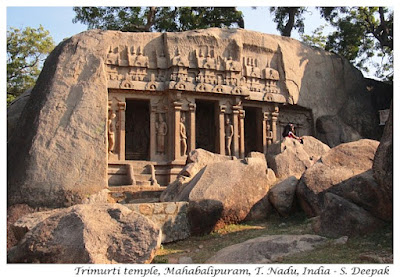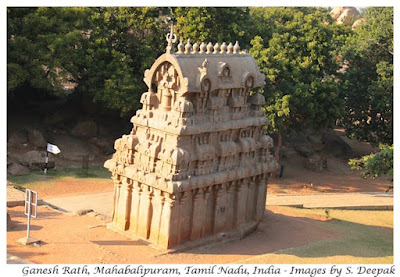This first part of the post explains the history of rock-cutting for construction in India and some rock-temples located in the park around the area surrounding the rock-sculptures known as Arjuna’s Penance. Part 2 of this post looks specifically at Arjuna's Penance itself.
History of Rock-Temples in India
Humans had inhabited natural rock-caves since prehistoric times. With their primitive tools they had started creating niches in those rocks. For example, in Bhimbetaka caves near Bhopal in central India, you can see some of these pre-historic man-made rock niches called "cupules" (image below).Over the next centuries, the idea of cutting rocks to create temples spread across central and south India. 5th to 8th century CE was the golden period of rock temples in India. In this period, a number of Hindu, Jain and Buddhist rock-temples were built in different parts of India – Rashtrakutas and Yadavs built Elephanta and Ellora (Maharashtra), Jain monks built Udaygiri (Madhya Pradesh), Chalukyas built Badami (Karnataka) and Pallavas built Mahabalipuram (Tamilnadu).
Building rock-temples required a lot of resources - to pay the skilled artisans who knew how to cut and mould the rocks over a period of years. Thus, each area of rock temples mentioned above, had a rich empire around it during 5-8th centuries CE. While there must have been some exchange of knowledge and skills between the artisans working in different parts of India, generations of artisans must have grown up and spent all their lives working the rocks in each of these places. Each of them developed their own specific styles. The rock-temples of Mahabalipuram are in what is called the Pallava style.
Building rock-temples required a lot of resources - to pay the skilled artisans who knew how to cut and mould the rocks over a period of years. Thus, each area of rock temples mentioned above, had a rich empire around it during 5-8th centuries CE. While there must have been some exchange of knowledge and skills between the artisans working in different parts of India, generations of artisans must have grown up and spent all their lives working the rocks in each of these places. Each of them developed their own specific styles. The rock-temples of Mahabalipuram are in what is called the Pallava style.
Process of Rock-Cutting Used in Mahabalipuram
Cutting the boulder must have been a long and hard work, requiring a knowledge about veins and planes of the rocks so that artisans knew where exactly to cut it. There are many other unfinished cut rocks in this area where you can see the process of cutting a rock and making rock-temples. For example, the image below shows that steps were cut in the rock and 3 niches were marked for making of statues, but the work was left unfinished.The next image shows a cut boulder with markings on the upper edge showing the places where holes were made.
However, the holes do not seem to be very deep. So how did making holes in a line, divided the boulder in two parts with smooth surfaces? Did they have one deeper hole where they pushed in an iron rod to act as a lever? Did they use water in some way to force the separation?
Do you have any ideas how they did it - If so, please share them in the comments below.
Kinds of Rock-temples in Mahabalipuram
In Mahabalipuram there are four kinds of rock-temples:(1) Open-air Bass-relief temples: Figures were sculpted on the rock surface.
(2) Temples in rock-caves: Caves were cut in the rock and then inside those caves, statues of deity in bass-relief or full sculptures were placed.
(3) Monolith temples: Big rocky boulders were taken and cut from the top-to-bottom, creating temples. In Mahabalipuram these are called “Rathas” (chariots).
(4) Built temples: Blocks of rocks were cut and then places one over another to create the temple.
Mammallapuram - Mahabalipuram: Myths & History
The original name of the town comes from the mythical king Bali, who was a very strong and powerful king. The legend says that Bali’s son was Banasur, who had imprisoned Anirudha, who was Krishna’s nephew and in love with Banasur’s daughter. Banasur was killed by Krishna. The town is also linked with the five Pandava brothers from “Mahabharat” and thus, different temples of the town are dedicated to them.The rock temples of Mahabalipuram were built by the Pallava kings, who had their capital in Kanchipuram, 70 km away to the west, and who used Mahabalipuram as their port to export spices and silks as far as the Mediterranean and Romans.
The first temples of Mahabalipuram were built under king Mahendra Varman (580-629 CE). His son Narsimha Varman 1st, was a strong wrestler (Malla) and gave another name to this place – Mahamallapuram or Mammallapuram. His son Mahendra Varman 2nd, who ruled only for 3 years (668-670 CE), has his name inscribed in Adivaraha temple, where the town’s name Mahabalipuram is also mentioned.
The Ganesha Ratha temple was built under Parmeshwara Varman (670-690 CE) while Rajasimha (690-728 CE) was responsible for the shore temple.
Arjun’s Penance Monument Park
The main rock temples of Mahabalipuram are located in three areas, of which two areas are next to the sea – the shore temple and a group of five temples known as “Pancha Rathas”. This post does not touch those monuments.The third area is a little away from the sea, where a granite hill is surrounded by a grassy land and this is known as the Arjun’s Penance area. Apart from the 1,500 years old temples, it also includes a light-house built in late 19th century under the British. It is very rich in monuments. This post is about some of the monuments of this area.
Trimurti Temple & the Round Water Tank
I entered this park from its north entrance, towards the Mahabalipuram bus-stand side. The first temple I saw was the Trimurti temple, which is a rock-cave temple with bass-relief statues of Brahma, Vishnu and Shiva.The sculptures of this temple are not very finally chiselled. At the same time, while Vishnu’s statue was recognisable, those of Shiva and Brahma did not have the distinctive features that we normally associate with their iconography. For example, the image below shows the Shiva sculpture from Trimurti temple – it is only the lingam in the foreground that identifies it as Shiva.
Outside the rock-temple, there is a circular water-tank cut into granite. It does not have steps for going inside, so it was not built as a usual temple-pond for the pilgrims. While cutting the rocks, a lot of water is needed to cool the surface. So, I wonder if they had created the circular tank to store water for the artisans, both for drinking and for rock-cutting? It is too well made in a perfect circle, to be used just for storage, so its purpose could have been two-fold – storing water while constructions were going on and then to remain there as a symbol of beauty in front of the temple.
Krishna’s Butter Ball
Between the Trimurti temple and the rest of the park, there are some huge granite boulders and the starting of a ridge that goes up towards the hill. As I walked on this ridge, I came across “Krishna’s butter ball”, a huge round boulder with its top surface cut smooth, that seems to be resting precariously on the rocks.It is the most popular tourist spot in the park, with people vying to get their selfies all around the boulder.
When I saw it, I asked myself if there was a story behind this boulder? Was it cut and then left in that place deliberately because it was visually striking? Or was it a work in progress which was left incomplete because of some external event like some war or lack of funds?
When I saw it, I asked myself if there was a story behind this boulder? Was it cut and then left in that place deliberately because it was visually striking? Or was it a work in progress which was left incomplete because of some external event like some war or lack of funds?
Ganesh’s Rath
This is a monolithic temple chiselled out from a single big boulder like a sculptor sculpts a statue. It is located a little to the south on the grass-land below Krishna's Butter Ball, along a rocky path that leads up to another granite hill.It looks like the wooden temples on the chariots used for the annual functions in the temples when deities are taken out in processions. Perhaps that is why such temples are called “Rath” (chariot).
Rayar Gopuram
The path going uphill from Ganesh’s rath leads to other constructions on the top, with a raised platform and pillars, including an entrance gate, which could have been somewhat like a Gopuram, that became popular in the temple architecture some centuries later.Other Rock Temples
As I walked around this area, I saw different rock-temples. Some of these had inscriptions, such as the one in Adivaraha temple in the image below, which I was told, includes the word Mahabalipuram. It would have been nice to have some boards outside showing the translations of the inscriptions.The area has many epigraphs whose meanings are not clear and it is likely that some of those were used by the temple-planners and builders as their annotations.
Conclusions
This first post about Mahabalipuram shows the richness of iconographies and rock-cut sculptures from 1,500 years ago. If you are interested in art, history and archaeology, you can spend hours in each of the temples described above and discover new things.The area known as Arjun’s Penance Monument Park has a large number of monuments - too many for one post! In this post I have limited myself to the northern and western parts of this area. The eastern and southern parts of this area, including the beautiful rock sculpture known as Arjuna's Penance will be the subject of my next post.
*****
#rocktemplesofindia #rockcutting #ancienttemples #hinduism #india #mahabalipuram




















No comments:
Post a Comment
Thanks for visiting Arre Kya Baat Hai and for your comment! Please use a civilised language. Comments with embedded links are removed.